|
|
1-Port and 2-Port ISDN-PRI Network Module Configuration Note
Product Numbers:
NM-1CT1, NM-1CT1-CSU, NM-2CT1, NM-2CT1-CSU, NM-1CE1-B, NM-2CE1-B, NM-1CE1-U, NM-2CE1-U
CPANM-1CT1, CPANM-1CT1-CSU, CPANM-2CT1, CPANM-2CT1-CSU, CPANM-1CE1-B, CPANM-2CE1-B, CPANM-1CE1-U, CPANM-2CE1-U
This document provides information about the following network modules for the Cisco 3600 series of modular access routers:
Figure 1 : 1-Port Channelized T1/ISDN-PRI Network Module

Figure 2 : 2-Port Channelized T1/ISDN-PRI Network Module
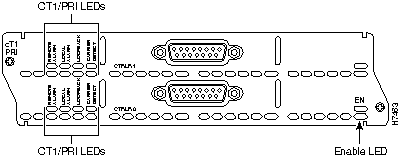
Figure 3 : 1-Port Channelized T1/ISDN-PRI with CSU Network Module

Figure 4 : 2-Port Channelized T1/ISDN-PRI with CSU Network Module
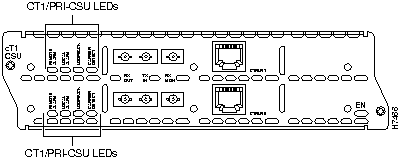
Figure 5 : 1-Port Channelized E1/ISDN-PRI Network Module (Balanced or Unbalanced)

Figure 6 : 2-Port Channelized E1/ISDN-PRI Network Module (Balanced or Unbalanced)
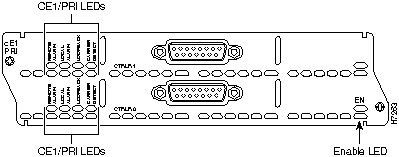
Use this document in conjunction with your router installation and configuration guide and the Regulatory Compliance and Safety Information publication. If you have questions or need help, refer to the section "Obtaining Service and Support" later in this document for further information.
This document contains the following sections:
![]()
Follow these guidelines to ensure general safety:
Follow these guidelines when working on equipment powered by electricity:
Preventing Electrostatic Discharge Damage
Electrostatic discharge (ESD) can damage equipment and impair electrical circuitry. It occurs when electronic printed circuit cards are improperly handled and can result in complete or intermittent failures. Always follow ESD prevention procedures when removing and replacing cards. Ensure that the router chassis is electrically connected to earth ground. Wear an ESD-preventive wrist strap, ensuring that it makes good skin contact. Connect the clip to an unpainted surface of the chassis frame to safely channel unwanted ESD voltages to ground. To properly guard against ESD damage and shocks, the wrist strap and cord must operate effectively. If no wrist strap is available, ground yourself by touching the metal part of the chassis.
You need the following tools and equipment to install a network module in a Cisco 3600 series chassis slot:
Installing PRI Network Modules in a Chassis Slot
The following instructions apply only to installing network modules in a chassis slot. To install a WAN interface card in a network module, see the configuration note for the WAN interface card.
You can install network modules in the chassis either before or after mounting the router, whichever is more convenient.
Follow this procedure to install a network module:
If the router is configured with fewer than four network modules, make sure that blank panels fill the open chassis slots to provide proper airflow. (See Figure 7.)
Figure 7 : Blank Network Module Panel
Connecting the PRI Module to the Network
This section explains how to connect a PRI network module to a WAN.
To connect a CT1/PRI module, use a DB-15-to-DB-15 T1 serial cable to connect the CT1/PRI port to a T1 CSU. (See Figure 8.)
Figure 8 : Connecting a CT1/PRI Module to a T1 CSU
To connect a CT1/PRI-CSU module, use a straight-through RJ-48C-to-RJ-48C cable to connect the RJ-48C port to an RJ-48C jack. (See Figure 9.)
Figure 9 : Connecting a CT1/PRI-CSU Module to an RJ-48C Jack
To connect a CE1/PRI-B (120-ohm) module, use the appropriate cable to connect the CE1/PRI-B port to an E1 CSU. (See Figure 10, Figure 11, and Figure 12, showing DB-15, Twinax, and RJ-45 CSUs respectively.)
Figure 10 : Connecting a 120-Ohm CE1/PRI-B Module to an E1 CSU (DB-15-to-DB-15 Connectors)
Figure 11 : Connecting a 120-Ohm CE1/PRI-B Module to an E1 CSU (DB-15-to-Twinax Connectors)
Figure 12 : Connecting a 120-Ohm CE1/PRI-B Module to an E1 CSU (DB-15-to-RJ-45 Connectors)
To connect a CE1/PRI-U (75-ohm) module, use the appropriate cable to connect the CE1/PRI-U port to an E1 CSU. (See Figure 13.) The illustration shows a CSU with BNC connectors.
Figure 13 : Connecting a CE1/PRI-U Module to an E1 CSU (DB-15-to-BNC Connectors)
This section describes PRI network module cables and lists their pinouts.
Two standard T1 serial cables are available for the CT1/PRI network module, straight-through and null-modem. A straight-through cable connects the router to an external channel service unit (CSU). Null-modem cables are used for back-to-back operation and testing.
T1 interface cables have two male DB-15 connectors (one at each end) to connect the CT1/PRI module with the external T1 CSU. Figure 14 shows the cable and connectors. Table 1 lists the pinout for the straight-through T1 cable, and Table 2 lists the pinout for the null-modem T1 cable.
Figure 14 : T1 Interface Cable
Table 1 : Straight-Through T1 Cable Pinout
Table 2 : Null-Modem T1 Cable Pinout
Table 3 lists the pinout for the CT1/PRI-CSU network module.
Table 3 : CT1/PRI-CSU Network Module (RJ-48C Port) Pinout
Cisco Systems offers three serial cables for 120-ohm balanced CE1/PRI-B network modules and one serial cable for 75-ohm unbalanced CE1/PRI-U network modules. All four E1 cables have a DB-15 connector at the router end. Cables for CE1/PRI-B modules have either DB-15, Twinax, or RJ-45 connectors at the network end. (See Figure 15, Figure 16, and Figure 17.) The cable for CE1/PRI-U modules has a BNC connector at the network end. (See Figure 18.)
Figure 15 : E1 Interface Cable for 120-Ohm Balanced Connections (DB-15 Connector)
Figure 16 : E1 Interface Cable for 120-Ohm Balanced Connections (Twinax Connectors)
Figure 17 : E1 Interface Cable for 120-Ohm Balanced Connections (RJ-45 Connector)
Figure 18 : E1 Interface Cable for 75-Ohm Unbalanced Connections (BNC Connectors)
Table 4 lists pinouts for the CE1/PRI cables.
All network modules have an enable LED. This LED indicates that the module has passed its self-tests and is available to the router.
All PRI modules display four additional LEDs for each port. These LEDs are described in Table 5.
Table 5 : ISDN-PRI Network Module LEDs
The following sections illustrate these LEDs.
Figure 19 and Figure 20 show CT1/PRI network module LEDs.
Figure 19 : 1-Port CT1/PRI Network Module LEDs
Figure 20 : 2-Port CT1/PRI Network Module LEDs
Figure 21 and Figure 22 show CT1/PRI-CSU module LEDs.
Figure 21 : 1-Port CT1/PRI-CSU Network Module LEDs
Figure 22 : 2-Port CT1/PRI-CSU Network Module LEDs
Figure 23 and Figure 24 show CE1/PRI module LEDs. The same LEDs are used for balanced (120-ohm) and unbalanced (75-ohm) E1 interfaces.
Figure 23 : 1-Port CE1/PRI Network Module LEDs
Figure 24 : 2-Port CE1/PRI Network Module LEDs
Configuring the PRI Interfaces
Whenever you install a new interface, or if you want to change the configuration of an existing interface, you must configure the interface. If you replace a module that was already configured, the router recognizes it and brings up the interface in the existing configuration.
Before you configure an interface, have the following information available:
To configure a PRI interface, you must use configuration mode (manual configuration). In this mode, you enter Cisco Internetwork Operating System (Cisco IOS) commands at the router prompt.
The following sections explain how to configure PRI interfaces. Before you begin, disconnect all WAN cables from the router to keep it from trying to run the AutoInstall process. The router tries to run AutoInstall whenever you power it ON if there is a WAN connection on both ends and the router does not have a valid configuration file stored in nonvolatile random-access memory (NVRAM) (for instance, when you add a new interface). It can take several minutes for the router to determine that AutoInstall is not connected to a remote Transmission Control Protocol/Internet Protocol (TCP/IP) host.
If you have questions or need help, refer to the section "Obtaining Service and Support" later in this document for further information.
The following procedure can be used to configure a new CT1/PRI or CT1/PRI-CSU module or to change the configuration of an existing module.
To enter configuration mode, follow this procedure:
The following procedure can be used to configure a new CE1/PRI module (balanced or unbalanced) or to change the configuration of an existing module.
To enter configuration mode, follow this procedure:
For service and support for a product purchased from a reseller, contact the reseller. Resellers offer a wide variety of Cisco service and support programs, which are described in the section "Service and Support" in the information packet that shipped with your chassis.
For service and support for a product purchased directly from Cisco, use CCO.
CCO is Cisco Systems' primary, real-time support channel. SMARTnet customers and partners can self-register on CCO to obtain additional content and services.
Available 24 hours a day, 7 days a week, CCO provides a wealth of standard and value-added services to Cisco's customers and business partners. CCO services include product information, software updates, release notes, technical tips, the Bug Navigator, configuration notes, brochures, descriptions of service offerings, and download access to public and authorized files.
CCO serves a wide variety of users through two interfaces that are updated and enhanced simultaneously---a character-based version and a multimedia version that resides on the World Wide Web (WWW). The character-based CCO supports Zmodem, Kermit, Xmodem, FTP, and Internet e-mail, and is excellent for quick access to information over lower bandwidths. The WWW version of CCO provides richly formatted documents with photographs, figures, graphics, and video, as well as hyperlinks to related information.
You can access CCO in the following ways:
For a copy of CCO's Frequently Asked Questions (FAQ), contact ccohelp@cisco.com. For additional information, contact ccoteam@cisco.com.
Please use CCO to obtain general information about Cisco Systems, Cisco products, or upgrades. If CCO is not accessible, contact 800 553-6387, 408 526-7208, or csrep@cisco.com.
Copyright 1988-1996 © Cisco Systems Inc.
![]()
![]()
![]()
![]()
![]()
![]()
![]()
![]()
![]()
![]()
![]()
![]()
![]()
![]()

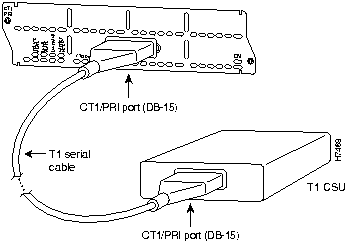
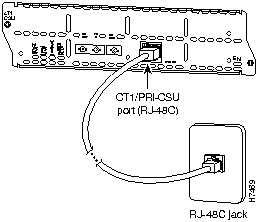
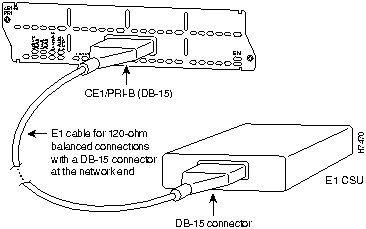
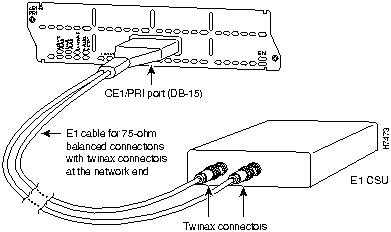
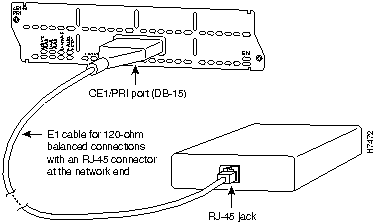
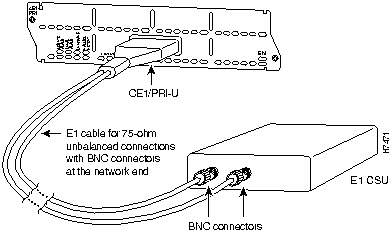
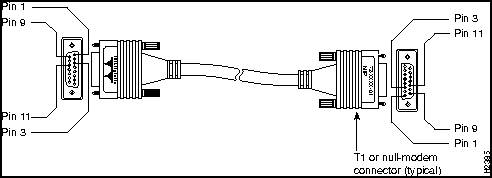
DB-15 Connector
DB-15 Connector
Signal
Pin
Pin
Signal
Transmit Tip
1
1
Transmit Tip
Transmit Ring
9
9
Transmit Ring
Receive Tip
3
3
Receive Tip
Receive Ring
11
11
Receive Ring
DB-15 Connector
DB-15 Connector
Signal
Pin
Pin
Signal
Transmit Tip
1
3
Receive Tip
Receive Tip
3
1
Transmit Tip
Transmit Ring
9
11
Receive Ring
Receive Ring
11
9
Transmit Ring
RJ-48C Pin
Signal
1
Receive Ring
2
Receive Tip
4
Ring
5
Tip




CE1/PRI End
Network End
DB-15
BNC
DB-15
Twinax
RJ-45
Pin
Signal1
Signal
Pin
Signal
Pin
Signal
Pin
Signal
9
Tx Tip
Tx Tip
1
Tx Tip
Tx-1
Tx Tip
4
Tx Tip
2
Tx Ring
Tx Shield
9
Tx Ring
Tx-2
Tx Ring
5
Tx Ring
10
Tx Shield
--
2
Tx Shield
Shield
Tx Shield
6
Tx Shield
8
Rx Tip
Rx Tip
3
Rx Tip
Rx-1
Rx Tip
1
Rx Tip
15
Rx Ring
Rx Shield
11
Rx Ring
Rx-2
Rx Ring
2
Rx Ring
7
Rx Shield
--
4
Rx Shield
Shield
Rx Shield
3
Rx Shield
1 Tx = transmit. Rx = receive.
LED
Meaning
REMOTE ALARM
Local alarm at remote end of connection
LOCAL ALARM
Loss of signal, loss of frame, or unavailability because of excessive errors
LOOPBACK
Controller local loopback
CARRIER DETECT
Carrier received on telco link

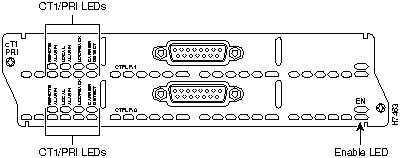

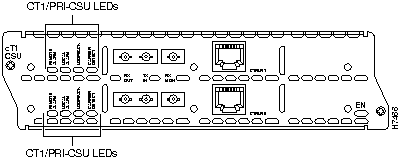

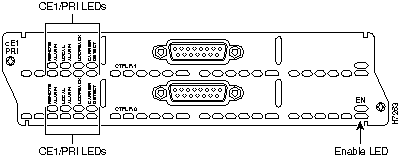
![]()
Would you like to enter the initial dialog? [yes]:
If the current configuration is valid, you enter the normal operating mode automatically.
Router>
enable
Password:
Router#
Router#
config terminal
Router(config)#
Router(config)#
ip routing
Router(config)#
appletalk routing
Router(config)#
ipx routing
Router(config)#
cont t1 1/0
Router(config-controller)#
clock source line
The clock source should be set to use internal clocking only for testing the network or if the full T1 line is used as the channel group. Only one end of the T1 line should be set to internal.
Router(config-controller)#
framing esf
Router(config-controller)#
linecode b8zs
Router(config-controller)#
%CONTROLLER-3-UPDOWN: Controller T1 1, changed state to up Router(config-controller)#
Router(config-controller)#
channel-group 0 timeslots 1,3-5,7
Router(config-controller)#
%LINEPROTO-5-UPDOWN: Line protocol on Interface Serial1/0:0, changed state to down
%LINEPROTO-5-UPDOWN: Line protocol on Interface Serial1/0:0, changed state to up Router(config-controller)#
Router(config-controller)#
Router(config-controller)#
int serial 1/0:0
Router(config-if)#
ip address 1.1.15.1 255.255.255.0
Router(config-if)#
Router(config)#
memory-size iomem 40
For further information about the memory-size iomem command, refer to the Cisco IOS configuration guides and command references.
Router#
show running-config
Router#
show startup-config
Router#
copy running-config startup-config
Building configuration. . .
[OK]
Router#
Would you like to enter the initial dialog? [yes]:
If the current configuration is valid, you enter the normal operating mode automatically.
Router>
enable
Password:
Router#
Router#
config terminal
Router(config)#
Router(config)#
ip routing
Router(config)#
appletalk routing
Router(config)#
ipx routing
Router(config)#
cont e1 1/0
Router(config-controller)#
framing crc4
Router(config-controller)#
channel-group 0 timeslots 1,3-5,7
Router(config-controller)#
%LINEPROTO-5-UPDOWN: Line protocol on Interface Serial1:0, changed state to down %LINEPROTO-5-UPDOWN: Line protocol on Interface Serial1:0, changed state to up Router(config-controller)#
Router(config-controller)#
Router(config-controller)#
int serial 1/0:0
Router(config-if)#
ip address 1.1.15.1 255.255.255.0
Router(config-if)#
Router(config)#
memory-size iomem 40
For further information about the memory-size iomem command, refer to the Cisco IOS configuration guides and command references.
Router#
show running-config
Router#
show startup-config
Router#
copy running-config startup-config
Building configuration. . .
[OK]
Router#

![]()
![]()
![]()
![]()
![]()
![]()
![]()
![]()